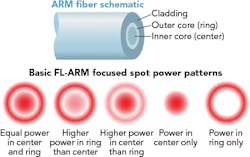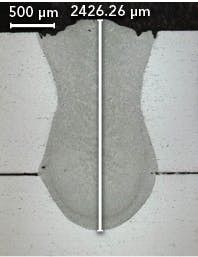Fiber laser enables successful welding of difficult materials
Technology yields high-speed, spatter-free processing of metals
JARNO KANGASTUPA
While fiber lasers are widely used for metal welding and cutting, there are some applications in which they still deliver less-than-ideal results. Welding of zinc-coated steel and aluminum are two important examples. This article presents a new embodiment of fiber laser technology that overcomes the prior limitations of fiber lasers in these applications.
Welding zinc-coated steel
Various types of zinc-coated steel are used extensively in automobiles as well as other applications where corrosion is an issue, such as in agricultural equipment and construction. However, in the past, zero-gap lap welding zinc-coated steel has presented a challenge for laser welding, as zinc has a substantially lower boiling temperature than steel. As a result, it evaporates first when the laser energy is applied to the material, and this creates gas pressure that can blow out the molten steel, resulting in an inconsistent weld seam as well as spatter that needs to be subsequently cleaned. There’s no easy way to control these dynamics with a single focused spot, because the laser power required to open and maintain the welding keyhole also produces a turbulent, unstable melt pool.
This problem is mitigated by either dimpling the material to create gaps, or adding spacers between the metal sheets, so that there is sufficient space (~0.1–0.5 mm) for the vaporized zinc to vent in a controlled manner to the side, rather than the top, of the keyhole. One major challenge with this approach is that it’s difficult to maintain a consistent small gap between the sheets for parts with complex, three-dimensional shapes, such as car doors. It’s far easier to create fixtures that clamp parts tightly together.
Aluminum welding
Electric cars are becoming increasingly popular with consumers, creating a growing need to weld the aluminum cases of the lithium batteries used in these vehicles. Specifically, the battery manufacturer must weld the top onto this case to obtain a hermetic seal over the lifetime of the component. It’s critical that this seal prevent moisture infiltration because water reacts strongly with lithium, creating gas and pressure that could destroy the device. Furthermore, it’s important that the welding process produce no spatter, as metal particles (as well as moisture) can create internal leakage currents that would short-circuit the battery. Finally, the weld must be mechanically strong enough to withstand rough treatment, or even the shock of a collision.
Sealing the aluminum battery case has traditionally been performed using laser conduction welding because the battery walls are thin (<1 mm). However, using conduction welding, it’s difficult to achieve sufficient penetration to produce a strong-enough weld with sufficiently low porosity to prevent the intrusion of moisture. But, using higher laser powers to achieve a deeper penetration (keyhole) weld runs the risk of deforming the casing, and virtually always causes some spattering.
FL-ARM technology
Past methods to eliminate the spatter problem experienced when processing certain materials with a fiber laser have included performing the laser process in a chamber at far below atmospheric pressure (in the millibar range), or drastically reducing the feed rate. But, these ultimately reduce throughput or create practical difficulties that negate the inherent advantages of the fiber laser. Until recently, there was no technique that could deliver fiber laser power in a manner that enables very precise control over the dynamics of the melt pool, supports market-enabling throughput, and is simple to implement.
Extensive development work at the Coherent applications laboratory in Tampere, Finland, has proven a new solution for high-speed, spatter-free processing of metals. This is achieved by modifying the intensity profile of the focused laser spot on the workpiece so that it departs significantly from the traditional, single-peaked Gaussian distribution. This research has shown that a beam consisting of a central Gaussian distribution spot, surrounded by another concentric ring of laser light, can often provide an effective approach.
Achieving this unusual configuration in the focused fiber laser spot is accomplished using Coherent’s FL-ARM specialized ring laser combiner and delivery fiber, developed by the company’s site in Finland (formerly Corelase). This fiber has a traditional circular core surrounded by another annular cross-section fiber core.
These systems can be built incorporating output from one to four separate fiber lasers, thus providing total maximum output powers from 2.5 to 10 kW. No matter what the exact configuration, in all cases the total beam profile (that is, the power in the center and the ring) can be independently adjusted on demand. Separate closed-loop power control systems for the center and ring beams also ensure excellent stability over the entire power adjustment range, which is from 1% to 100% of the nominal output maximum output. The core and ring beams can even be independently modulated, at repetition rates up to 5 kHz.
FIGURE 1. The simplified ARM fiber schematic and the five basic power patterns possible in the focused laser spot are shown.
In this arrangement (FIGURE 1), there are virtually an unlimited number of possible combinations in terms of the power ratio of the inner to the outer beam. However, all these can be broadly grouped into the configurations shown in the figure. These basic patterns can then be varied to deliver a wide range of processing characteristics to optimally service a diverse set of applications.
Applications results
Testing of this technology on zinc-coated steel sheets has proven the ability to perform welding without the need for a gap between the parts. In this case, the beam is configured to have power in both the center and the ring, as opposed to the traditional single laser spot. The ring is primarily responsible for performing the welding, although it divides the process into two steps. First, the leading edge of the outside ring pre-heats the workpiece, while the additional energy required to perform welding is delivered by the trailing side of the ring. Dividing the supplied laser energy in two and spreading it out over a larger area produces a larger melt pool and reduces the temperature gradient in the material, all of which reduces spatter (FIGURE 2).
FIGURE 2. Cross-sections show the weld seam for 1.25-mm-thick zinc-coated steel processed using a fiber laser without a gap between the sheet and at a feed rate of 3.3 m/min, where conventional laser focusing creates a seam with voids (a) and the FL-ARM creates a weld seam with excellent uniformity and no porosity (b).
At the same time, the center spot maintains the keyhole (at a lower temperature than at the edges), which pushes molten material to the sides. This allows the zinc gas to vent out easily through the center without producing any spatter, even when the parts are clamped together with zero gap.
Also, because the ring beam is rotationally symmetric, the orientation of the beam doesn’t have to be changed to follow the direction of the weld seam, which might vary substantially on a contoured or shaped part. This greatly simplifies its implementation.
Keyhole welding can be performed successfully in this application with the FL-ARM laser. The result is a strong weld absent of deformation. Again, the beam is configured with power in both the center and in the ring.
This approach works because the leading edge of the ring beam raises the aluminum temperature sufficiently to increase its absorption at the laser wavelength. Then, the center of the beam creates the keyhole, which is now very stable because of the pre-heating. The trailing edge of the ring beam sustains the melt pool sufficiently to allow gas to escape. Because the keyhole is stable and the material doesn’t resolidify as fast, the entire process is more consistent and the process window is larger. The ultimate result (FIGURE 3) is uniform, consistent material penetration and higher-quality, porosity-free welds without spatter.
FIGURE 3. This cross-section of a weld in stack of two 1.6-mm-thick 5000 Series aluminum parts shows deep penetration with no pores or spatter.
Fiber lasers are used in many industrial processes, but no single product embodiment is optimum for every use. This is the reason that laser manufacturers, such as Coherent | Rofin, have developed a broad range of different fiber laser implementations. The company then pairs these products with extensive process knowledge to extend their utility, delivering better results such as reduced spatter, improving throughput, and reducing production costs for the user,
JARNO KANGASTUPA ([email protected]) is business director & product line manager of custom fiber lasers at Coherent, Tampere, Finland; www.coherent.com.


